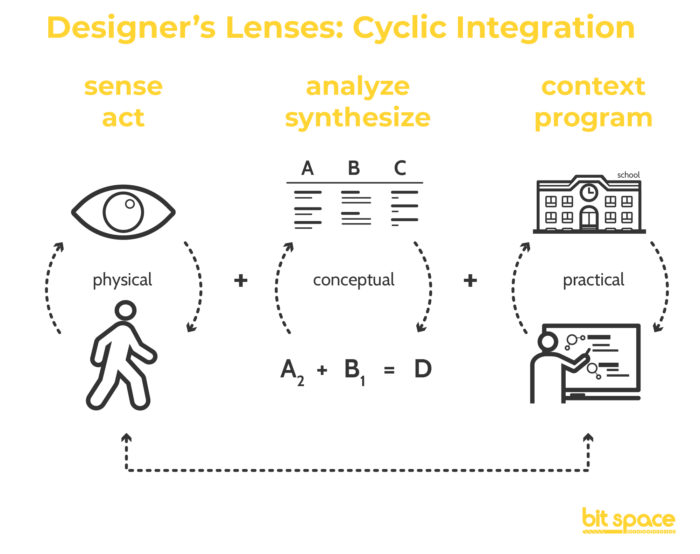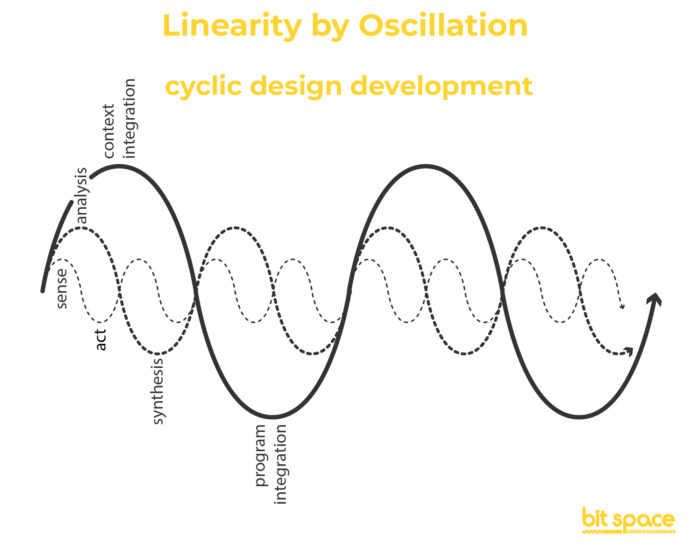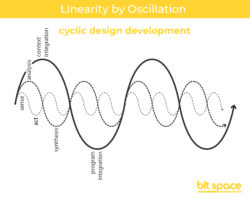Designer’s Lenses
Concept
Territories
Level
Overview
Designer’s Lenses
Designer’s Lenses > Overview
When we design, we set out to solve some kind of problem. Unlike a math problem or a riddle, there is no correct answer, no codified set of actions to create a solution. Instead, designers approach their problems with a variety of lenses which help break the problem down into chunks, and then build up a solution based on those chunks.
Our core lenses are pairs of words that represent different modes of engaging with design. In the physical, bodily mode we have Sensing + Acting; in the mental, conceptual mode we have Analysis + Synthesis; in the practical, designing mode we have Context + Program. Each pair of words represent the two halves of a cycle like Day + Night: one proceeds into the other, then returns to the first, repeating endlessly. The first word generally is a type of input that will affect our design solution, and the second word is an output that becomes part of our design solution.
The lenses also present modes of problem-solving, a very vague guide through the process of designing. A good metaphor to understand this would be the scientific method.
Sensing + Acting
The lens of Sensing aligns with stages of initial observation and reflective assessment: you gather observable information with your body’s five senses about the topic of interest. Acting is part of this pair because each action is a result of some sensation–think about how moving your location (acting) changes what you can observe (sensing).
Analysis + Synthesis
The lens of Analysis + Synthesis would parallel forming a hypothesis in the scientific method. Gathering all the observations/sensations, you look for patterns that occur–which is an act of analysis. Based on said patterns, you propose a possible explanation which synthesizes both the things you observed and your analysis of them.
Context + Program
Finally, the lens of Context + Program would be like designing and running an experiment. You create a scenario that simulates whatever you were observing (the context), then follow a procedure (program) that intends to recreate the observed phenomenon in a controlled way.
Linearity by Way of Oscillation
Once we have produced some output through our design process, we begin again: we look with each of our lenses at what we’ve done. Sometimes this means we return to the drawing table, so to speak, and continue refining our design solution; other times, we take the information we’ve gleaned and apply it to the next problem we must solve.
In the end, everything we do to forward our design development will be done in a linear fashion. The progression of time predicates doing thing 1, then thing 2, then thing 2.1, then 2.3, then 3, etc. However, if a design process is inescapably linear, the line itself is surely not straight. Instead, the design process will feel like you are going forward, backward and sometimes every which way. You will spiral around and split off in different directions only to return. This is why we shy away from thinking too rigidly about any specific steps you must take in a design process.
What we know is that if the design is intended to be built in some real, physical way, the design process will go from thinking more conceptually, to thinking more practically. We will usually spend more time researching, sensing and analyzing our context, and then use that knowledge to synthesize and act out our program.
As the program of the design gains focus, we will progress in ever-increasing levels of detail towards an explanation of how the design is intended to exist. Over the course of this relatively linear progression, we will oscillate back and forth between sensing and acting, analysis and synthesis, and context and program.
Like a ship sailing into the wind, we must tack first one way, then another. After we sense and analyze, we pivot to synthesis and program. We create a first design, then return to our other modalities to see how our design changes the context, how it affects sensation. With the knowledge gained from our first design, we move on to a second, each iteration furthering our program, but always touching back where we came from.
Standards
Designer’s Lenses > Overview
- NGSS
- Disciplinary Core Idea
- Engineering Design




